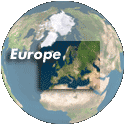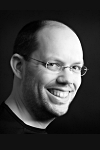
Preparing a Bubble Bath
Frankfurt am Main, Germany
June 19, 2005 - 11:45 UTC (13:45 local time)
© 2005 Jürgen Matern, All Rights Reserved.
The idea
As water is an "every day" element of our lives I wanted to show a typical "every day" use of water. In a discussion of this theme with a friend of mine we ran into the idea of taking panoramic images in a bath tub (thanks to Ralf for the funny discussion of pano-shooting in a bath tub).Making Of
- Back at home I placed my tripod in the bath tub, mounted my panoramic head on it and saw that the head was way to bulky to be turned around it's vertical axis. It was then, when I recalled my first fisheye approach with my first digital camera.
- There is no fisheye-converter available for my first digital camera. It's even worse, as there is no filter screw thread at the front of the lens. As I wanted to take fisheye-style pictures with the camera I had to think about a different solution. At the time I started my search for a solution I ran across a soup ladle of WMF in the shape of a hemishpere and so a possible mirror for fisheye photography. The name of the product is "Schöpflöffel (Profi Plus, article number 18 7101 6030)". The ladle is polished and has a diameter of 9cm/3,5" and you can search the site of WMF, if you want additional information on the ladle. Click here for a picture of the ladle.
- Currently equipped with a digital SLR camera I decided to use this soup ladle for my WWP605 panorama.
- As I wanted to place the ladle right above the surface of the water I just taped the ladle onto a flower pot. Click here for a picture of the mounted ladle.
- The camera was mounted as far away from the ladle as possible. This led to the solution of mounting the camera at a pole which was fixed at the pole of the shower curtain. The positive effect of this was, that I hadn't to deal with a tripod for the camera. Click here for a picture of the whole setup.
- Thus the distance between ladle and camera was fixed and couldn't be changed. To capture the ladle with maximum resolution I therefore had to use a zoom lens. As a picture with my 80-200 lens @ 200mm still had room for more pixels of the ladle I finally ended up with a 2x converter behind the lens, the lens @ 110mm. Now the ladle perfectly fitted on the whole sensor but I wasn't able to get a sharp picture as I ran into trouble with the near focus distance of the lens. So I additionally mounted a 12mm intermediate ring and everything was fine.
- As a flash was useless in this configuration this led to an exposure of 3 sec. @ ISO 100 and aperture 16.
- I took one picture in the described configuration. Click here for the mirror shot. This picture was remapped into a equirectangular projection using panotools and PTGui. Due to the extreme picture angle of the ladle I only had a very small area which wasn't in the final panorama.
- As I wanted to minimize retouching I took a second picture with my 18mm attached to the camera and the ladle removed. Click here for the bath tub shot.
- I took PTEditor and extracted nadir and zenith of the equirectangular projection. In the zenith image I removed the camera and the second shot of the tub was inserted into the nadir image. Reinserting of nadir and zenith via PTEditor and here you go.
Conclusions
As you see, my panorama is technically a one-shot panorama with only limited resolution and therefore it made no sense to produce a fullscreen version. But I think it would have been a very hard (if not impossible) job to do this panorama with multiple images because I'm visible over a really big angle of the panorama.Lenses:
- Minolta 2,8/80-200mm @ 110mm, Converter 2x with 12mm intermediate ring (for mirror shot)
- Sigma 3,5/18mm (shot without mirror)
Software: Panotools, PTGui, Gimp, PanoScript, PanoCube+
Pictures: 2 picture @ 6MP (one with mirror, one without mirror)


 Tap or click the zoom icon in the bottom right corner of the picture to switch between in-page and fullscreen view
Tap or click the zoom icon in the bottom right corner of the picture to switch between in-page and fullscreen view